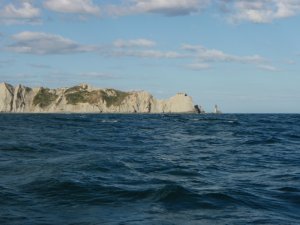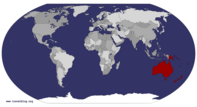Advertisement
Published: January 18th 2009

 Tuaheni Point
Tuaheni Point
northern headland to Poverty BayGisborne - Tauranga (round East Cape)
Captains Log:
Took on board 205 litres of fuel. Left Gisborne at 1630hrs on Wednesday 16th December 2008. Headed out to a force 3 south easterly wind which once out of Poverty Bay and heading north east promptly died. Laid a northerly track till 5 nautical miles north east of East Cape. Force 3 westerly now in place so headed north west towards the Bay of Plenty. Three hours later tacked inshore in the region of Hicks Bay and then attempted to motor west until past Cape Runaway. Sea very choppy - East Cape was trying to keep us there. Laid a course south of White Island just off the wind and motor sailed for several hours. A change of wind direction altered the vessels travel such that now heading for White Island - an adjustment of course to north of White Island increased both speed and reduced vessels movement. Maintained course till after breakfast at which stage possible to lay Tauranga directly. Entry into Tauranga with tide straight forward, apart from all the mad recreational fishers in fizz boats.
No 1’s version:
For me our trip round East Cape was to prove
the most challenging part of the journey to date, and the longest. So while The Captain’s Log makes it all sound fairly straight forward, I don’t think you will be surprised to discover things were not as cut and dried as his words lead one to believe.
Poverty Bay, in comparison to Hawkes Bay is very small. You can see it all in the sweep of your eyes and it is very picturesque with the lovely surf beach which frames the township of Gisborne. We headed out in a good wind, the Captain very happy to be putting up the sails, and as always excited to be on the next phase of the journey. Sadly, as soon as we turned up the coast, the wind died and we were forced to motor again in flat calm water - a bonus for me, much muttering from The Captain! However, it did allow us to have the most benefit from the Common Dolphins who joined us and swam with the boat for about half an hour. Full of The Captain’s famous red lentil pasta dish, the weather calm, the dolphins having provided entertainment I would have to say it was hugely
enjoyable and what I thought I had signed on for.
The trip up the eastern most part of New Zealand is far less rugged than the Wairarapa Coast. We were able to travel much closer to the land and make out the small communities along the coast. I was fascinated by the Gable End Foreland which look like the gable of a house and is very distinctive approaching from the South. The most densely populated bay appeared to be Tolaga Bay which I saw on my first night watch, and which is about half way between Poverty Bay and East Cape. Once again I had a beautiful moon, stars to think by and calm weather. Great stuff.
The sun came up on my second shift, and I watched East Cape coming up on our port (left) side. I had been watching it and several large vessels which passed us. So when I went below for my rest the weather was good, the sea was calm, we were nearly parallel with East Cape and all was well with the world.
Three hours later I woke up to find a vastly different scene. We were now looking back on
East Cape - way, way in the distance. We were heading in a westerly direction across the north face of the cape. The wind had picked up considerably, the Captain was in seventh heaven because he was now sailing and the sea had gone from dead calm to VERY lumpy.
And then he disappeared into the cabin for his three hours off.
Well I can tell you that I sat there for some time taking it all in, and feeling the boat climb the swells and the rush down the other side. I couldn’t do anything about it of course (where was I going to go), but as I sat there, and to coin a phrase made famous by Terry Pratchett’s characters Nanny Ogg and Granny Weatherwax - ‘headology’ set in. My head went to the circus and a came up with every possible worst case scenario available to me within my scope of knowledge. I was suddenly very uncomfortable on the boat and my head was not doing me any favours.
So I did what every self respecting semi novice (no longer completely novice, I have been on the boat since Wellington after all) sailor would
do. I woke the Captain and demanded to know why we were so far from shore, why it was so lumpy (he can really control that) and why he had made the decision to come this way in the first place. Sensing I was ready to step over the side and try to walk back to Wellington we did a slight change of course to take us closer to the shore. And, as he always does, the Captain talked me through my fears and put my mind to rest.
And then there was a thump. I was on the helm and I felt an impact to the rudder (really a good time for it given my headspace at that point - stop the boat I want to get off!). The Captain heard the impact. Looking back he saw the sunfish we had just collided with. Sunfish can get up to a tonne in weight though this one was not that big. And luckily for us, its encounter with Hakura was far more damaging for it than it was for us.
Shortly afterwards the steering became unresponsive. I, of course, thought the impact with the sunfish had caused the
problem, but on investigation The Captain found that the rollercoaster ride had resettled some equipment in the stern locker by the steering apparatus and with that re-stowed we were back in business.
The change of tack did result in things becoming a little less lumpy. That was until we back on course and we were riding the roller coaster again. When I say roller coaster, I mean roller coaster. At times you feel the boat climbing a wave and you are willing it to get to the top, you can feel it slowing right down in its efforts to climb. Then you are racing down the other side to meet the next wave head on. About every seventh (yes, I counted) wave is a big one and that is when you feel the boat straining. That ride went on for something like 18 hours, and I was well and truly over it by the time we got out of it. When we passed Cape Runaway, the irony of not being able to run away was well and truly noted.
I would like to go back a little. I think I have mentioned that when there are two of us on board and we are travelling over a night or two, we do three hour shifts. Every hour we check our position. We had had a few problems at one stage with not keeping to the charted course so I was a bit paranoid about it. When I am told to wake The Captain if there is anything I am not sure about, I do. Every hour on the hour I woke him. And he was pleased I did, or so he said.
Except that when the next time came for me to be on the helm we were still in the lumpy stuff, the motor was going as well as the sails, and so his nibs charted the course, set the auto pilot and told me that for the next three hours there was nothing we could hit so if I did not want to check the position that would be fine. I was more than happy with that given the boat was having such a good time rock and rolling that getting into the cabin was a challenge, let alone reading the GPS and marking the chart appropriately. So I didn’t bother. It took me all my time to keep the old ‘headology’ at bay, do the checks on the boat, and try to deal with the rocking and rolling.
However, just about at the end of the shift I noticed something trailing along side us in the water and had to wake the Captain. It was the main halyard (the rope that pulls up the mainsail) that had been washed over the side. Full marks to The Captain for his prowess at getting around the boat in the worst of conditions!
Up anyway, he decided to chart our position. And guess what. We had not stayed on course. No only had we not stayed on course, we were heading straight for White Island (about 5 nautical miles off). Joy! A change of course was required and he suddenly had a rush of blood to the head and decided to head north instead of south of the island. This resulted in our being on a tack that took us with the swell rather than over it therefore profoundly reducing the rocking and rolling of the boat. I suspect being out of the influence of the Cape also had an effect.
The morning found us in calmer seas, and I would have to say the sunrise was particularly magnificent - all the more so because it dawned a calm day. It was wonderful to see White Island - I have heard of it but never seen it, so to do so at such close quarters was awesome. The Bay of Plenty is amazingly large. I had thought Hawkes Bay was big, but it is a baby by comparison. I spent my childhood years having camping holidays at Bowentown Camp looking out to Mayor Island and across to Matakana Island, so it was amazing for me to see it all from the other side.
The approach to Tauranga through the The Mount is interesting because as you get closer to it, the apartment blocks start to rise up and are very distinctive on the coastline. We stayed at the Bridge Marina and were delighted with the assistance we received to berth the boat. The other notable thing about the marina was the hundreds of jelly fish of all colours and patterns carried by the tide; some flowing past others caught in eddys. The Captain has developed a whole new theory of evolution where jellyfish are the master race, and humans are bending to their design. I don’t think he should give up his day job - if he had one.
One of the great things about marinas when you have been on a long trip is the showers. I just luxuriate in a hot shower at the end of a leg. But this time we had a minor problem in that we had taken on water during the voyage, surprise, surprise (it turned out to be a blocked anchor locker drain) and we found that all our bedding and linen was wet, all our clothes were wet, and when we opened the store cupboard there was not a single piece of linen or a towel that did not need washing because it has been doused with salt water. Thank heaven for marina facilities and Aunt’s and Uncle’s who not only come to the rescue but provide chocolate cake as well. Thanks so much Aunty Iris and Uncle Russell. We don’t know what we would have done without you.
Advertisement
Tot: 0.071s; Tpl: 0.016s; cc: 9; qc: 25; dbt: 0.0463s; 1; m:domysql w:travelblog (10.17.0.13); sld: 1;
; mem: 1mb









